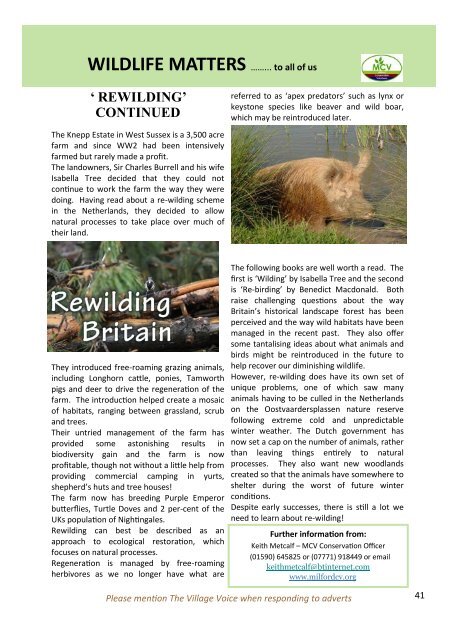Village Voice June July 19
community
community
You also want an ePaper? Increase the reach of your titles
YUMPU automatically turns print PDFs into web optimized ePapers that Google loves.
WILDLIFE MATTERS ……... to all of us<br />
‘ REWILDING’<br />
CONTINUED<br />
The Knepp Estate in West Sussex is a 3,500 acre<br />
farm and since WW2 had been intensively<br />
farmed but rarely made a profit.<br />
The landowners, Sir Charles Burrell and his wife<br />
Isabella Tree decided that they could not<br />
continue to work the farm the way they were<br />
doing. Having read about a re-wilding scheme<br />
in the Netherlands, they decided to allow<br />
natural processes to take place over much of<br />
their land.<br />
referred to as ‘apex predators’ such as lynx or<br />
keystone species like beaver and wild boar,<br />
which may be reintroduced later.<br />
They introduced free-roaming grazing animals,<br />
including Longhorn cattle, ponies, Tamworth<br />
pigs and deer to drive the regeneration of the<br />
farm. The introduction helped create a mosaic<br />
of habitats, ranging between grassland, scrub<br />
and trees.<br />
Their untried management of the farm has<br />
provided some astonishing results in<br />
biodiversity gain and the farm is now<br />
profitable, though not without a little help from<br />
providing commercial camping in yurts,<br />
shepherd’s huts and tree houses!<br />
The farm now has breeding Purple Emperor<br />
butterflies, Turtle Doves and 2 per-cent of the<br />
UKs population of Nightingales.<br />
Rewilding can best be described as an<br />
approach to ecological restoration, which<br />
focuses on natural processes.<br />
Regeneration is managed by free-roaming<br />
herbivores as we no longer have what are<br />
The following books are well worth a read. The<br />
first is ‘Wilding’ by Isabella Tree and the second<br />
is ‘Re-birding’ by Benedict Macdonald. Both<br />
raise challenging questions about the way<br />
Britain’s historical landscape forest has been<br />
perceived and the way wild habitats have been<br />
managed in the recent past. They also offer<br />
some tantalising ideas about what animals and<br />
birds might be reintroduced in the future to<br />
help recover our diminishing wildlife.<br />
However, re-wilding does have its own set of<br />
unique problems, one of which saw many<br />
animals having to be culled in the Netherlands<br />
on the Oostvaardersplassen nature reserve<br />
following extreme cold and unpredictable<br />
winter weather. The Dutch government has<br />
now set a cap on the number of animals, rather<br />
than leaving things entirely to natural<br />
processes. They also want new woodlands<br />
created so that the animals have somewhere to<br />
shelter during the worst of future winter<br />
conditions.<br />
Despite early successes, there is still a lot we<br />
need to learn about re-wilding!<br />
Further information from:<br />
Keith Metcalf – MCV Conservation Officer<br />
(01590) 645825 or (07771) 918449 or email<br />
keithmetcalf@btinternet.com<br />
www.milfordcv.org<br />
Please mention The <strong>Village</strong> <strong>Voice</strong> when responding to adverts<br />
41


















